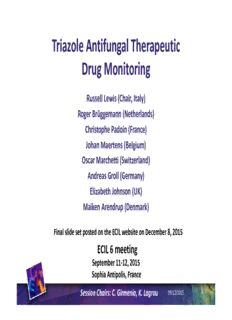
Triazole Antifungal Therapeutic Drug Monitoring PDF
Preview Triazole Antifungal Therapeutic Drug Monitoring
Triazole Antifungal Therapeutic Drug Monitoring Russell Lewis (Chair, Italy) Roger Brüggemann (Netherlands) Christophe Padoin (France) Johan Maertens (Belgium) Oscar Marchetti (Switzerland) Andreas Groll (Germany) Elizabeth Johnson (UK) Maiken Arendrup (Denmark) Final slide set posted on the ECIL website on December 8, 2015 ECIL 6 meeting September 11‐12, 2015 Sophia Antipolis, France Session Chairs: C. Girmenia, K. Lagrou 09/12/2015 1 Previous ECIL recommendations: ECIL‐4 2011: Pediatric fungal diseases ECIL‐5 2013: Antifungal recommendations • TDM was not extensively addressed for antifungal treatment • TDM was recommended for primary antifungal prophylaxis* • Voriconazole to improve efficacy, safety • Target trough: 1‐5 mg/L • Posaconazole to improve efficacy • Target trough: > 0.7 mg/L • Itraconazole to improve efficacy, safety • Target trough: > 0.5 mg/L; toxicity 17.0 mg/L (bioassay) *No evidence grading was applied in this section Available: http://www.kobe.fr/ecil/program2013.htm, accessed 24 June 2015 09/12/2015 2 Groll et al. Lancet Oncology 2014:e327‐e340. ECIL 6 charges: • Identify key questions concerning azole therapeutic drug monitoring (TDM) in patients with haematological malignancies /allogeneic HSCT • Provide evidence‐based recommendations or expert opinion addressing key questions (ESCMID/EFISG scoring system) Haematology / Pharmacology Clinical reference laboratory Infectious diseases Russell Lewis (Italy) Johan Maertens (Belgium) Elizabeth Johnson (UK) Roger Brüggemann (Netherlands) Oscar Marchetti (Switzerland) Maiken Arendrup (Denmark) Christophe Padoin (France) Andreas Groll (Germany) 09/12/2015 8 3 Evidence grading‐ ESCMID/EFISG scoring system Strength of Recommendation Definition (SoR) Grade A ECIL strongly supports a recommendation for use Grade B ECIL moderately supports a recommendation for use Grade C ECIL marginally supports a recommendation for use Grade D ECIL supports a recommendation against use Quality of Evidence (QoE) Definition Level I Evidence from at least 1 properly* designed randomized, controlled trial (orientated on the primary endpoint of the trial) Level II Evidence from at least 1 well‐designed clinical trial (including secondary endpoints), without randomization; from cohort or case‐controlled analytic studies (preferably from > 1 centre; from multiple time series; or from dramatic results of uncontrolled experiments Level III Evidence from opinions of respected authorities, based on clinical experience, descriptive case studies, or reports of expert committees Added Index Source of Level II Evidence r Meta‐analysis or systematic review of RCT t Transferred evidence, that is, results from different patients’ cohorts, or similar immune‐status situation h Comparator group: historical control u Uncontrolled trials a Published abstract presented at an international symposium or meeting *poor quality of planning, inconsistency of results, indirectness of evidence etc.… would lower the SoR 09/12/2015 4 Ullmann A et al. Clin Microbiol Infect 2012; 18 (Suppl. 7). Key questions‐Pharmacology • What are the specific azole PK/PD considerations that support the need for TDM? • Which triazoles should be monitored? 09/12/2015 10 5 Standard TDM criteria Triazole Significant PK Therapeutic range Narrow variability? defined in therapeutic humans? window? Fluconazole ✔ yes ✔ yes ✘ 09/12/2015 6 TDM needed for fluconazole? • Substantial PK variability (>30% CV) in some populations may result in subtherapeutic exposures • Critically‐ill patients with sepsis1,2 • Hemodialysis (CVVH or CVVHD, CVVHDF ) • Pediatrics3 • Fluconazole has a broad therapeu(cid:415)c index → possibly more practical to empirically administer higher weight‐ based doses (e.g., 8‐12 mg/kg/day) • Uncertainty regarding best monitoring strategy: • Estimate AUC/MIC (target > 100)…1, 2 and 4hr sample? continuous venovenous hemofiltration (CVVH) 1. Ashbee et al. J Antimicrob Chemother 2014;69:1162‐76. continuous venovenous hemodialysis (CVVHD) 2. Sinnollareddy et al. Crit Care 2015;19:33 continuous venovenous hemodiafiltration (CVVHDF) 3. van der Elst et al. Clin Infect Dis 2014;59:1527‐1533 09/12/2015 TDM may be beneficial for fluconazole in special circumstances ? • Hemodialysis/hemofiltration +/‐ sepsis • CNS infections • Pediatrics • Infections cause by pathogens with elevated MICs (>2‐4 mg/L) • Patients at risk for QTc prolongation (especially in setting of renal disease)? Fluconazole TDM may be helpful to guide dosing for rare treatment circumstances to target: AUC/MIC > 100; AUC 400 mg·h/L; or trough of > 10 to 15 mg/L (BIII) 09/12/2015 Parameter Substantial PK Therapeutic range Narrow variability? defined in therapeutic humans? window? Fluconazole ✔ yes ✔ yes ✘ no Itraconazole ✔ yes ✔ yes ✔ yes Voriconazole ✔ yes ✔ yes ✔ yes Posaconazole * ✔ yes ✔ yes ? not well defined Isavuconazole ** ✔ yes ✘ no ? not well defined *Limited data for new posaconazole formulations **Limited data 09/12/2015 9 Key questions‐Pharmacology • What are the specific azole PK/PD considerations that support the need for TDM? • Which triazoles should be monitored? • What target levels are recommended for each triazole? • When should azole concentrations be evaluated and re‐ evaluated? How is dosing adjusted? 09/12/2015 10
Description: